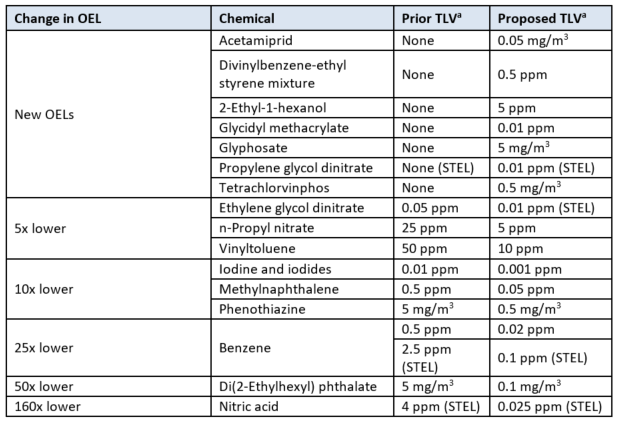December 1, 2022
Update on OELs in Development
Occupational exposure limits (OELs) are airborne concentrations of chemicals recommended as guidance or promulgated as regulatory exposure limits for the protection of worker health. Periodically, OEL-setting organizations develop new limits for chemicals that lack them and re-evaluate existing limits, which they either retain or revise. Below, we provide updates on the current work of the major OEL-setting organizations in the US.
American Conference of Governmental Industrial Hygienists (ACGIH) Threshold Limit Values (TLVs)
ACGIH’s TLV-Chemical Substance (TLV-CS) Committee identifies chemicals and physical agents for which to develop or revise TLVs and places them on its “Under Study” list. Every year, the Committee issues proposed new or revised TLVs in the form of Notices of Intended Changes (NICs).
The Notices of Intended Changes Issued by ACGIH

Notes: STEL = Short-Term Exposure Limit. (a) Values are time-weighted averages (TWAs), unless otherwise noted.
In September 2022, ACGIH announced several changes to its TLV development process for 2023: the “Under Study” list will no longer be tiered, the Committee will be able to add chemicals to the list at any time, and comment periods for NICs will be offered twice per year, each lasting three months.
Occupational Safety and Health Administration (OSHA) Permissible Exposure Limits (PELs)
OSHA has not indicated that any PELs are currently in development.
National Institute for Occupational Safety and Health (NIOSH) Recommended Exposure Limits (RELs)
Currently, NIOSH notes that RELs for two chemicals are “under development” – toluene diisocyanate and 1-bromopropane. However, NIOSH last updated the “Peer Review Agenda” information for these RELs in 2016.
Occupational Alliance for Risk Science (OARS) Workplace Environmental Exposure Levels (WEELs)
This year, the OARS WEEL Committee developed a new WEEL for difluoroethylene, (E)-1,2 (HFO-1132 [E]) (350 ppm). WEELs for dimethyl ether and triethylenetetramine (TETA) are currently in the public comment stage.
As part of OEL development, many OEL-setting organizations offer opportunities for organizations to provide comments and/or submit data or other information about chemicals as part of their OEL development processes. Gradient scientists understand occupational exposures and the studies upon which OELs are based; we can support clients who want to contribute to the OEL-setting process for chemicals of importance to them. We provide information, analysis, and advice on a wide range of occupational health and risk issues.
Contacts:
Lisa A. Bailey, Ph.D.
Principal Scientist
David G. Dodge, M.S., DABT, CIH
Principal Scientist
Julie C. Lemay, M.P.H.
Senior Environmental Health Scientist
Tom A. Lewandowski, Ph.D., DABT, ERT, ATS
Principal
Christopher M. Long, Sc.D., DABT
Principal